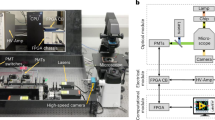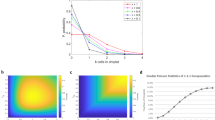Abstract
Cell-penetrating peptides (CPPs) have garnered significant attention as a method to introduce reporters and therapeutics into intact cells. While numerous studies have been performed identifying new CPP sequences, relatively little is known about their uptake efficiency at the single-cell level. Here, a droplet microfluidic trapping array was used to characterize CPP uptake across a population of single intact cells. The microfluidic device allowed for facile and rapid isolation and analysis of single-cell fluorescence in a 787-member overhead trapping array with > 99% droplet trapping efficiency. The permeability efficiencies of four different CPPs were studied and compared in HeLa cells. Population analysis was performed using linkage hierarchical cluster analysis by R programming to bin cells into subpopulations expressing very low to very high peptide uptake efficiencies. CPP uptake was observed to be heterogeneous across the population of cells with peptide concentration and sequence both playing important roles in the diversity of CPP uptake, the overall peptide uptake efficiency, and the intracellular homogeneity of peptide distribution. This microfluidic-based analytical approach finds application in personalized medicine and provides new insight in the heterogeneity of CPP uptake which has the potential to affect both biosensor and drug internalization in intact cells.

.






Similar content being viewed by others
References
Hamley I. Small bioactive peptides for biomaterials design and therapeutics. Chem Rev. 2017;117(24):14015–41. https://doi.org/10.1021/acs.chemrev.7b00522.
Craik D, Fairlie D, Liras S, Price D. The future of peptide-based drugs. Chem Biol Drug Des. 2013;81(1):136–47. https://doi.org/10.1111/cbdd.12055.
Juan G-V, Morris CM. Fluorescent reporters and biosensors for probing the dynamic behavior of protein kinases. Proteomes. 2015;3(4):369–410.
Kovarik M, Allbritton N. Measuring enzyme activity in single cells. Trends Biotechnol. 2011;29(5):222–30. https://doi.org/10.1016/j.tibtech.2011.01.003.
Di Carlo D, Lee L. Dynamic single-cell analysis for quantitative biology. Anal Chem. 2006;78(23):7918–25.
Cai L, Friedman N, Xie X. Stochastic protein expression in individual cells at the single molecule level. Nature. 2006;440(7082):358–62. https://doi.org/10.1038/nature04599.
Wang J, Zhan Y, Bao N, Lu C. Quantitative measurement of quantum dot uptake at the cell population level using microfluidic evanescent-wave-based flow cytometry. Lab Chip. 2012;12(8):1441–5. https://doi.org/10.1039/c2lc21298f.
Murphy T, Zhang Q, Naler L, Ma S, Lu C. Recent advances in the use of microfluidic technologies for single cell analysis. Analyst. 2018;143(1):60–80. https://doi.org/10.1039/c7an01346a.
Reece A, Xia B, Jiang Z, Noren B, McBride R, Oakey J. Microfluidic techniques for high throughput single cell analysis. Curr Opin Biotechnol. 2016;40:90–6. https://doi.org/10.1016/j.copbio.2016.02.015.
Wang J, Bao N, Paris L, Wang H, Geahlen R, Lu C. Detection of kinase translocation using microfluidic electroporative flow cytometry. Anal Chem. 2008;80(4):1087–93. https://doi.org/10.1021/ac702065e.
Shang L, Cheng Y, Zhao Y. Emerging droplet microfluidics. Chem Rev. 2017;117(12):7964–8040. https://doi.org/10.1021/acs.chemrev.6b00848.
Du G, Fang Q, den Toonder J. Microfluidics for cell-based high throughput screening platforms-a review. Anal Chim Acta. 2016;903:36–50. https://doi.org/10.1016/j.aca.2015.11.023.
Pekin D, Skhiri Y, Baret J, Le Corre D, Mazutis L, Ben Salem C, et al. Quantitative and sensitive detection of rare mutations using droplet-based microfluidics. Lab Chip. 2011;11(13):2156–66. https://doi.org/10.1039/c1lc20128j.
Sjostrom S, Joensson H, Svahn H. Multiplex analysis of enzyme kinetics and inhibition by droplet microfluidics using picoinjectors. Lab Chip. 2013;13(9):1754–61. https://doi.org/10.1039/c3lc41398e.
Jin S, Lee S, Lee B, Jeong S, Peter M, Lee C. Programmable static droplet array for the analysis of cell-cell communication in a confined microenvironment. Anal Chem. 2017;89(18):9722–9. https://doi.org/10.1021/acs.analchem.7b01462.
Toseland CP. Fluorescent labeling and modification of proteins. J Chem Biol. 2013;6(3):85–95. https://doi.org/10.1007/s12154-013-0094-5.
Brouzes E, Medkova M, Savenelli N, Marran D, Twardowski M, Hutchison J, et al. Droplet microfluidic technology for single-cell high-throughput screening. Proc Natl Acad Sci U S A. 2009;106(34):14195–200. https://doi.org/10.1073/pnas.0903542106.
Khorshidi M, Rajeswari P, Wahlby C, Joensson H, Svahn H. Automated analysis of dynamic behavior of single cells in picoliter droplets. Lab Chip. 2014;14(5):931–7. https://doi.org/10.1039/c3lc51136g.
Jackson-Holmes E, McDevitt T, Lu H. A microfluidic trap array for longitudinal monitoring and multi-modal phenotypic analysis of individual stem cell aggregates. Lab Chip. 2017;17(21):3634–42. https://doi.org/10.1039/c7lc00763a.
Safa N, Anderson JC, Vaithiyanathan M, Pettigrew JH, Pappas GA, Liu D et al. CPProtectides: rapid uptake of well-folded β-hairpin peptides with enhanced resistance to intracellular degradation. Pept Sci 2018:e24092.
Qian Z, LaRochelle J, Jiang B, Lian W, Hard R, Selner N, et al. Early endosomal escape of a cyclic cell-penetrating peptide allows effective cytosolic cargo delivery. Biochemistry. 2014;53(24):4034–46. https://doi.org/10.1021/bi5004102.
Mazutis L, Gilbert J, Ung W, Weitz D, Griffiths A, Heyman J. Single-cell analysis and sorting using droplet-based microfluidics. Nat Protoc. 2013;8(5):870–91. https://doi.org/10.1038/nprot.2013.046.
Qian Z, Liu T, Liu Y, Briesewitz R, Barrios A, Jhiang S, et al. Efficient delivery of cyclic peptides into mammalian cells with short sequence motifs. ACS Chem Biol. 2013;8(2):423–31. https://doi.org/10.1021/cb3005275.
Brock G, Pihur V, Datta S, Datta S. clValid: an R package for cluster validation. J Stat Softw. 2008;25(4):1–22.
Charrad M, Ghazzali N, Bioteau V, Niknafs A. NbClust: an R package for determining the relevant number of clusters in a data set. J Stat Softw. 2014;61(6):1–36.
Collins DJ, Neild A, deMello A, Liu A-Q, Ai Y. The Poisson distribution and beyond: methods for microfluidic droplet production and single cell encapsulation. Lab Chip. 2015;15(17):3439–59. https://doi.org/10.1039/C5LC00614G.
Handl J, Knowles J, Kell D. Computational cluster validation in post-genomic data analysis. Bioinformatics. 2005;21(15):3201–12. https://doi.org/10.1093/bioinformatics/bti517.
Dunn C. Well-separated clusters and optimal fuzzy partitions. J Cybern. 1974;4:95–104.
Rousseeuw P. Silhouettes - a graphical aid to the interpretation and validation of cluster-analysis. J Comput Appl Math. 1987;20:53–65. https://doi.org/10.1016/0377-0427(87)90125-7.
Brunner S, Sauer T, Carotta S, Cotten M, Saltik M, Wagner E. Cell cycle dependence of gene transfer by lipoplex polyplex and recombinant adenovirus. Gene Ther. 2000;7(5):401–7. https://doi.org/10.1038/sj.gt.3301102.
El-Sayed A, Futaki S, Harashima H. Delivery of macromolecules using arginine-rich cell-penetrating peptides: ways to overcome endosomal entrapment. AAPS J. 2009;11(1):13–22. https://doi.org/10.1208/s12248-008-9071-2.
Brock R. The uptake of arginine-rich cell-penetrating peptides: putting the puzzle together. Bioconjug Chem. 2014;25(5):863–8. https://doi.org/10.1021/bc500017t.
Cao Z, Geng S, Li L, Lu C. Detecting intracellular translocation of native proteins quantitatively at the single cell level. Chem Sci. 2014;5(6):2530–5. https://doi.org/10.1039/c4sc00578c.
Gomez JA, Chen J, Ngo J, Hajkova D, Yeh I-J, Gama V, et al. Cell-penetrating penta-peptides (CPP5s): measurement of cell entry and protein-transduction activity. pharmaceuticals. 2010;3:3594–613.
Duchardt F, Fotin-Mleczek M, Schwarz H, Fischer R, Brock R. A comprehensive model for the cellular uptake of cationic cell-penetrating peptides. Traffic. 2007;8(7):848–66. https://doi.org/10.1111/j.1600-0854.2007.00572.x.
Acknowledgments
The authors would like to thank Dr. Nancy Allbritton (University of North Carolina) for providing the GFP-HeLa and OPM-2 cells. The authors would also like to thank Dr. Ted Gauthier (LSU AgCenter Biotechnology Lab) for assistance in the synthesis and purification of the peptides used in this study. The authors would also like to thank Joseph B. Balhoff for assistance in producing the graphical abstract and Riad Elkhanoufi and Wayne Wortmann III for some assistance with device fabrication.
Funding
This work was supported by grants from the National Institute of Biomedical Imaging and Bioengineering (R03EB02935) and the National Science Foundation (CBET1509713) awarded to ATM.
Author information
Authors and Affiliations
Corresponding author
Ethics declarations
Conflict of interest
The authors declare that they have no conflict of interest.
Additional information
Publisher’s note
Springer Nature remains neutral with regard to jurisdictional claims in published maps and institutional affiliations.
Electronic supplementary material
ESM 1
(PDF 1823 kb)
Rights and permissions
About this article
Cite this article
Safa, N., Vaithiyanathan, M., Sombolestani, S. et al. Population-based analysis of cell-penetrating peptide uptake using a microfluidic droplet trapping array. Anal Bioanal Chem 411, 2729–2741 (2019). https://doi.org/10.1007/s00216-019-01713-5
Received:
Revised:
Accepted:
Published:
Issue Date:
DOI: https://doi.org/10.1007/s00216-019-01713-5




